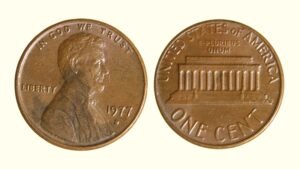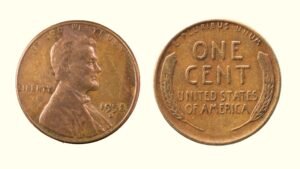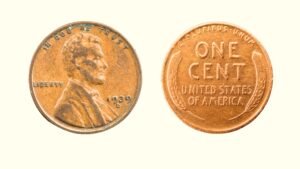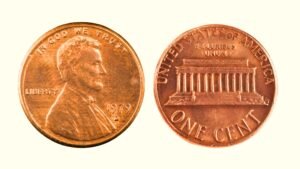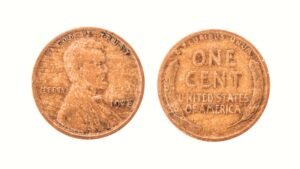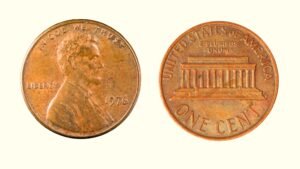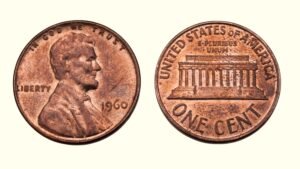The 1977 Lincoln Penny might look like an ordinary copper coin from the ’70s, but did you know this is the same coin that was sold at a coin auction for over $7,000? Surprising, right? What if I tell you that you might also earn such a big fortune if you have this small cent in your coin collection?
But wait! Not all 1977 Lincoln cents are expensive. In fact, many are just worth a few cents to a few dollars. So, how will you know if your penny is worth the big money? This guide will help you learn about all rare features, including grades, mint marks, and errors that can transform your old penny into big bucks!

Brief History of 1977 Lincoln Memorial Cent
The 1977 Lincoln Penny is a part of the Modern Cent series, featuring President Abraham Lincoln on the obverse and the Lincoln Memorial on the reverse. The roots of this coin goes back to 1909 when the first Lincoln Penny was released featuring wheat stalks on the reverse.
In 1959, the reverse design was replaced by engraver Gilroy Roberts’s Lincoln Memorial design. Despite the change, the coin was well-established in American currency by 1977.
Being one of the last copper Lincoln pennies until the composition was finally changed to copper-plated zinc in 1982, this coin has decent popularity among coin collectors to date!
| 1977 Lincoln Memorial Cent | Key Features & Facts |
| Coin Composition | 95% Copper, 5% Tin and Zinc |
| Minting Location | Philadelphia, Denver, San Francisco |
| Minting Year | 1977 |
| Face Value | 1-cent (0.01$) |
| Weight | 3.11 grams |
| Diameter | 19.05 mm |
| Thickness | 1.52 mm |
| Designer | Victor David Brenner, Frank Gasparro |
| Mint Marks | D – Denver Mint, S – San Francisco Mint, No Mint Mark – Philadelphia Mint |
| Total Mintage | 7,271,888,452 |
Identifying a 1977 Memorial Cent Design & Composition
To spot a 1977 Lincoln penny among other old pennies, you need to recognize its distinct design elements and understand its composition and size.
1977 Lincoln Penny Obverse:

- A right-facing profile of Abraham Lincoln
- “LIBERTY” to the left of Lincoln’s portrait
- The US motto, “IN GOD WE TRUST,” above Lincoln’s head
- The mint year “1977” to the right of Lincoln’s portrait
- The mint mark, if present, below the mint year.
1977 Lincoln Penny Reverse:
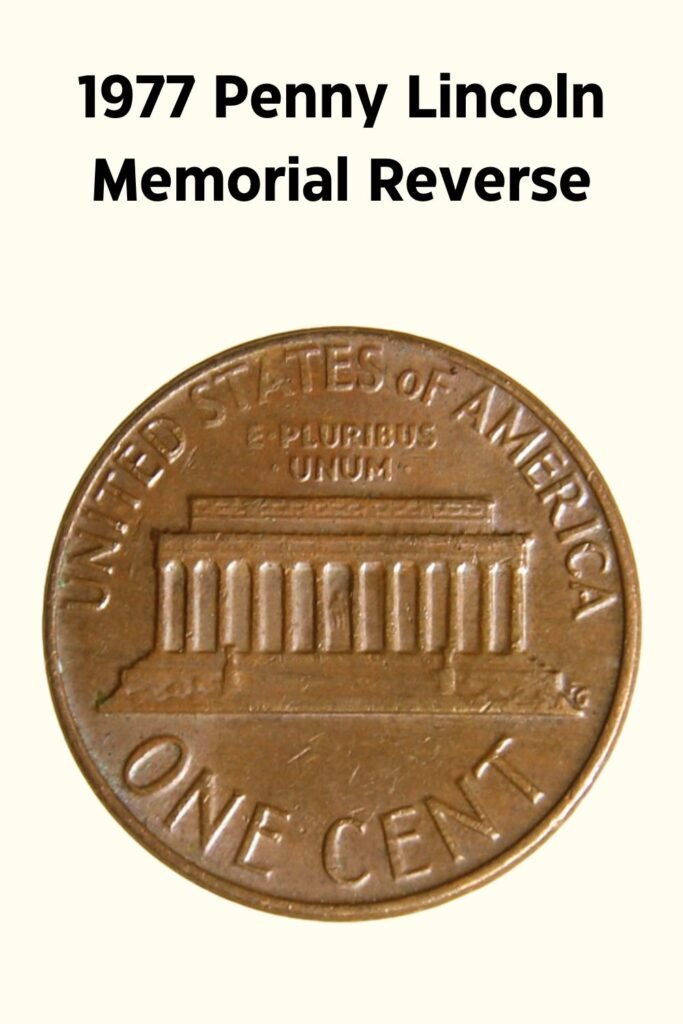
- Lincoln Memorial building in the center
- “ONE CENT” below the Memorial building
- “E·PLURIBUS·UNUM” above the Memorial
- “UNITED STATES OF AMERICA” along the upper rim
- The Designer’s initials “FG” on the right side of the Memorial stairs
1977 Lincoln Cent Composition & Dimensions
The 1977 Lincoln Memorial Cent is composed of 95% copper and 5% zinc, the traditional bronze alloy that gives it the iconic reddish-brown luster. The coin weighs around 2.5 grams and has a diameter of 19.05 millimeters. Besides, it has a thickness of 1.52 millimeters with a uniform plain edge, like all Lincoln pennies!
Note: There is a misconception that the 1977 Penny was also issued in a silver clad. All Pennies are copper.
5 Factors to Assess a 1977 Lincoln Penny Value
Generally, the value of a 1977 Lincoln Penny in circulated condition ranges from one cent to 20 cents. However, this value can reach $5,000 or more based on coin grade, mint mark, and mint errors. Let’s understand these factors in detail!
1. Coin Grading and Condition
Assessing the condition of your 1977 Lincoln penny is crucial to finding its real value. Generally, the pennies are graded on a scale from PO-1 to MS-70, where MS-70 indicates a flawless, mint coin. You can visually analyze your 1977 cent’s condition based on scratches, wear, and design.
Higher grades 1977 Lincoln pennies such as MS-68 or above can easily fetch $5,000 to $7,000 in a coin auction.
2. Coin Toning & Color
The toning and discoloration of a 1977 Penny due to oxidation also impacts its value. Generally, the pennies are graded in three designations based on the colors:
- Red (RD): Red 1977 pennies are those that have over 95% of their original bright, red color. These are the most desirable pennies, commanding higher prices of a few thousand dollars (in higher mint grades only).
- Red-Brown (RB): Pennies that display a mix of red and brown hues on the surface are graded RB. They are less valuable than pure red coins but can still fetch a decent price, often around $2 to $5.
- Brown (BN): The 1977 Lincoln pennies that have turned completely brown due to oxidation are graded BN. These coins are generally the least valuable, often worth only a few cents unless they have a rare mint error or the highest grade.
3. Mint Marks & Mintage
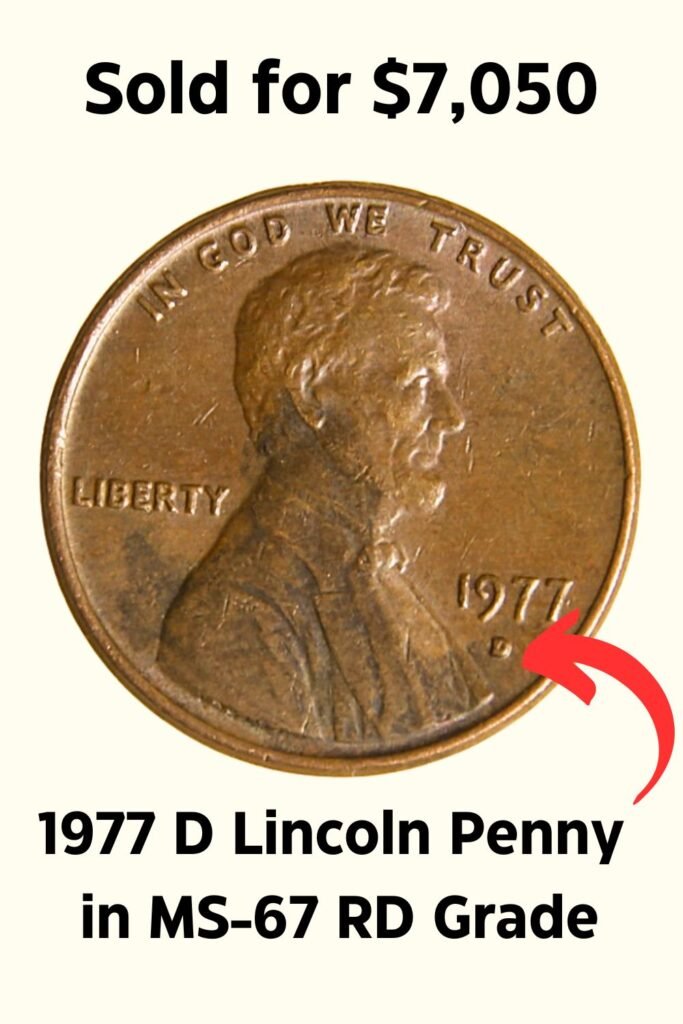
The 1977 Lincoln Penny was minted at three locations, each with varying mintages and mint marks that can affect its final worth.
- 1977 No Mint Mark Penny: The Philadelphia Mint produced around 3,074,575,000 pennies, bearing no mint mark. These coins are worth around $0.01 in average or circulated condition, but uncirculated examples can reach up to $2 or more.
- 1977 D Lincoln Penny: The Denver mint released around 4,194,062,300 1977 pennies, identified by the “D” mint mark. Like Philadelphia cents, a circulated 1977 D Penny is valued at $0.01, while uncirculated coins can fetch up to $60 in common grades (MS-66) and $200 or more in higher grades.

This 1977 Lincoln Cent value chart will help you find the coin’s average value based on grades (for red coins) and mint marks.
| Coin Grades | Condition Details | 1977 No Mint Mark Penny Value | 1977 D Wheat Penny Value |
| Poor (0) to Extremely Fine (XF45) | Significant wear, faded but visible details | Face Value | Face Value |
| Almost Uncirculated (AU50) to Mint State (AU58+) | Slight wear on highest points, visible marks or blemishes | 20 cents to 50 cents | 10 cents to 30 cents |
| Mint State (MS60 – MS64) | Uncirculated with minimal wear | $1 – $5 | $1 – $10 |
| Mint State (MS65 – MS66+) | Nearly flawless with very minor imperfections | $8 – $35 | $10 – $60 |
| Mint State (MS67 – MS67+) | Well-preserved with no major flaws | $65 – $550+ | $120 – $2,250+ |
| Mint State (MS68 or Above) | Nearly perfect, luster, no major marks or flaws | N/A | $7,050 or more |
4. 1977 Lincoln Penny Proof Coins
Apart from the regular pennies, the United States Mint released proof 1977 Lincoln pennies from San Francisco for collectors. With an “S” mint mark, these coins feature a higher-quality finish and a lower mintage and are more collectible than circulation pennies.
The 1977 S penny proof coins are also designated in three categories:
- Regular PR Proofs: These 1977 proof cents feature the standard proof finish with a mirror-like surface. They are generally slightly more than standard 1977 pennies, with values ranging from $5 to $10, depending on their condition or PR grades.
- Cameo (CAM) Proofs: 1977 proof coins that display a stronger contrast between the frosted design and the mirror-like background are graded as “Cameo” or “CAM.” 1977-S 1C CAM coins can fetch over $20 for well-graded examples.
- Deep Cameo (DCAM) Proofs: These coins feature the sharpest contrast between the frosted and mirrored surfaces, making them rare to find! In the highest grade, PR-70, DCAM 1977 pennies can fetch around $1,500 or more, while lower-grade examples are worth $10 to $30.

5. Valuable 1977 Lincoln Penny Errors List
A 1977 Lincoln Penny can be more valuable with minting errors (flaws that occur during the striking process). Some of the most valuable 1977 penny errors are as follows:
Off-center Strike
This error happened when a 1977 Lincoln Memorial Cent blank was not properly aligned in the die, leading to a partial impression. These errors can make the penny valuable as long as the mint date is visible. The value ranges from $50 to $200, depending on the degree of misalignment and the coin’s color and grade.

BIE Error
This error features a small bridge between the letters “B” and “E” in “LIBERTY” due to a die break. To spot this, look for a slightly raised line between the two letters. The value of 1977 BIE pennies can range from $5 to $15, with high-grade examples fetching more.
Cud Die Break
To spot this error, look for a raised lump on your 1977 penny coin’s surface. This happens when a piece of the die breaks off. Depending on the coin’s condition and intensity of the cud, these coins can be worth up to $250 (or more for better grades), like this MS64BN example that sold for over $215 on Heritage Auctions.

Struck on a Clad 10C Blank
This is one of the rare wrong planchet errors in which a 1977 Lincoln Cent is struck on a clad 10-cent planchet. You can identify this rare coin by its curved edges as well as its weight, size, and composition. An MS-64 grade example of this error coin sold for $675 on eBay!

How to Know If a 1977 Lincoln Penny Is Real or Fake?
If you are not sure about your 1977 penny’s authenticity, follow these four steps to find out whether it’s fake or not:
- Check the Weight: If your 1977 penny’s weight is significantly more or less than 3.11 grams, it could be fake.
- Measure the Coin: If your coin is too much wider or smaller than 19.05 mm or too much thinner or thicker than 1.52 mm, it’s a big no.
- Examine the Edge: If your coin’s edge has unusual markings, breaks, or reeding, it’s definitely a counterfeit.
- Look for Mint Marks: If the mint mark of your 1977 cent coin appears to have a different font or style than verified coins, it could be a fake. Pay attention to the placement, too, especially for the 1977-S pennies.
Note: This article is intended for informational, educational, and entertainment purposes only. Some images are illustrative and may not represent actual brands, products, or related entities. All trademarks, product names, brand logos, packaging, and other intellectual property referenced remain the exclusive property of their respective owners. Any brand mentions or references are provided solely for descriptive and educational context and do not imply any formal or commercial association.

